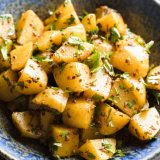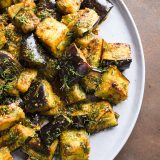First you hear him, a piercing clarion cutting the sky. Tattered Egyptian flag in hand, the teenager whistles from a tall and crumbling rooftop, dozens of pigeons roller-coaster swooping around him. His red shirt pops amid the sea of brown that is Cairo, buildings battered and homogenous, swept with the dust of two deserts.
He signals the birds, not us. Who cares? It has been a defeating day. Insipid, slick, acclaimed cafés with menus dull, starchy and heavy. None of the bold-stroke vibrance I’d come for. So tossing caution, my photographer and I find and ascend the derelict steps beneath the teenager, a spiraling, unlit trail that deposits us four stories later in a one-room home. At the center, a wooden ladder poking upward still.
Mother and father wordlessly invite us in, motioning us up to a shaky roof quilted from broken wooden pallets and fractured bits of furniture. There, we find ... dinner? The boy—balanced even higher on precariously constructed, gently cooing coops—is a pigeon caller, trapping, training and releasing them in an elaborate dance with the evening sky. When it works, the released birds will return with new friends. Some of them are eaten.
An hour later and humbled for finally seeing something of the real Cairo, we stumble back streetside. Lesson learned—here, serendipity might reward more than planning. If we were to get a taste of true Egyptian food—a cuisine birthed with the pharaohs and formed over centuries at a trade crossroads of Japanese, Indian, Chinese and European influences—a more intrepid approach was needed.
In that spirit, we cancel our sure-to-be-banal dinner reservations and wander, soon passing through the 1,000-year-old Bab al Futuh, or Conquest Gate, one of three massive stone arched entries into the Old City. A torrent of bleating traffic greets us; crossing it calls to question our commitment to life.
But on the other side, we find Restaurant Zezo—really just a window in a wall crowned with a cheap replica of the Bab al Futuh. Seating is three plastic tables that wobble by the roadside, honking, exhaust fumes, abandoned cars and feral cats our company. Boys collect cardboard in a donkey-drawn cart. A pickup truck with an elaborately made mattress tied to the back crawls past. The marital bed of a wedding celebrated by a second truck packed with cheering women in bright hijab.
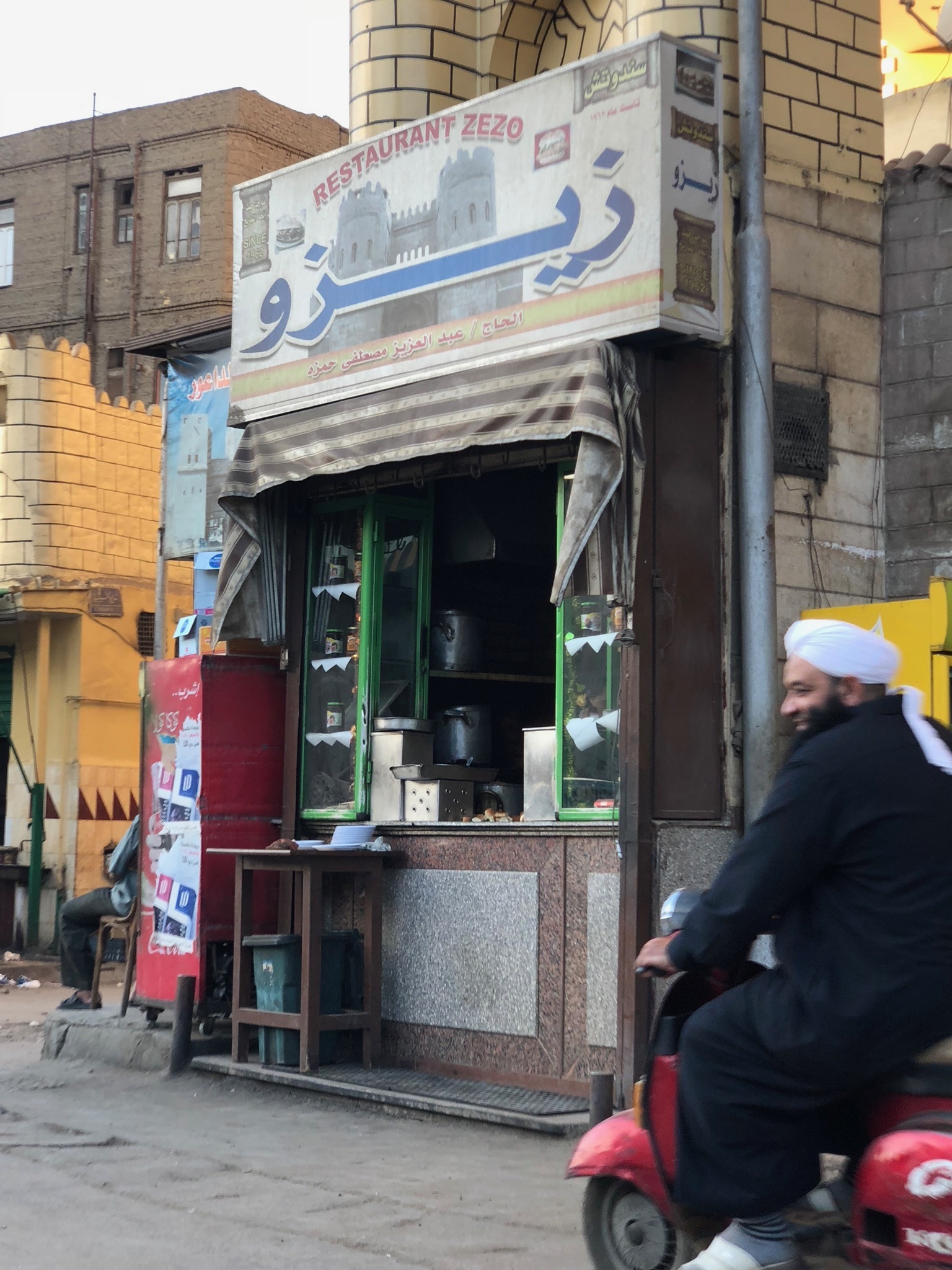
Ahmed Abdelaziz—whose grandfather started the eatery nearly 60 years ago—kneels by the table, explaining that at Zezo one must eat the liver sandwiches and patates mekhalel, or pickled potatoes. Truthfully, neither sings to me, but both arrive quickly. The liver, tucked into buns and drizzled with tahini—a classic combination—is everything you’d expect.
But the potatoes! Tender chunks—boiled, not roasted—cooled and studded with cumin and coriander ground so coarsely they offer as much texture as flavor. It’s a revelation to think of spices this way; we so often reduce them to a powder. The dressing is light, with hits of chili spice, garlic and vinegar, the latter balancing the kick of the spices. They are simple and wonderful. They are vibrant. And only while Abdelaziz again kneels by the table—this time to explain the recipe—do I notice the line of customers at the window, each walking away with small plastic bags of the potatoes.

At streetside bakeries across Cairo, boys rush to stack and deliver tender, puffed pita-like breads.
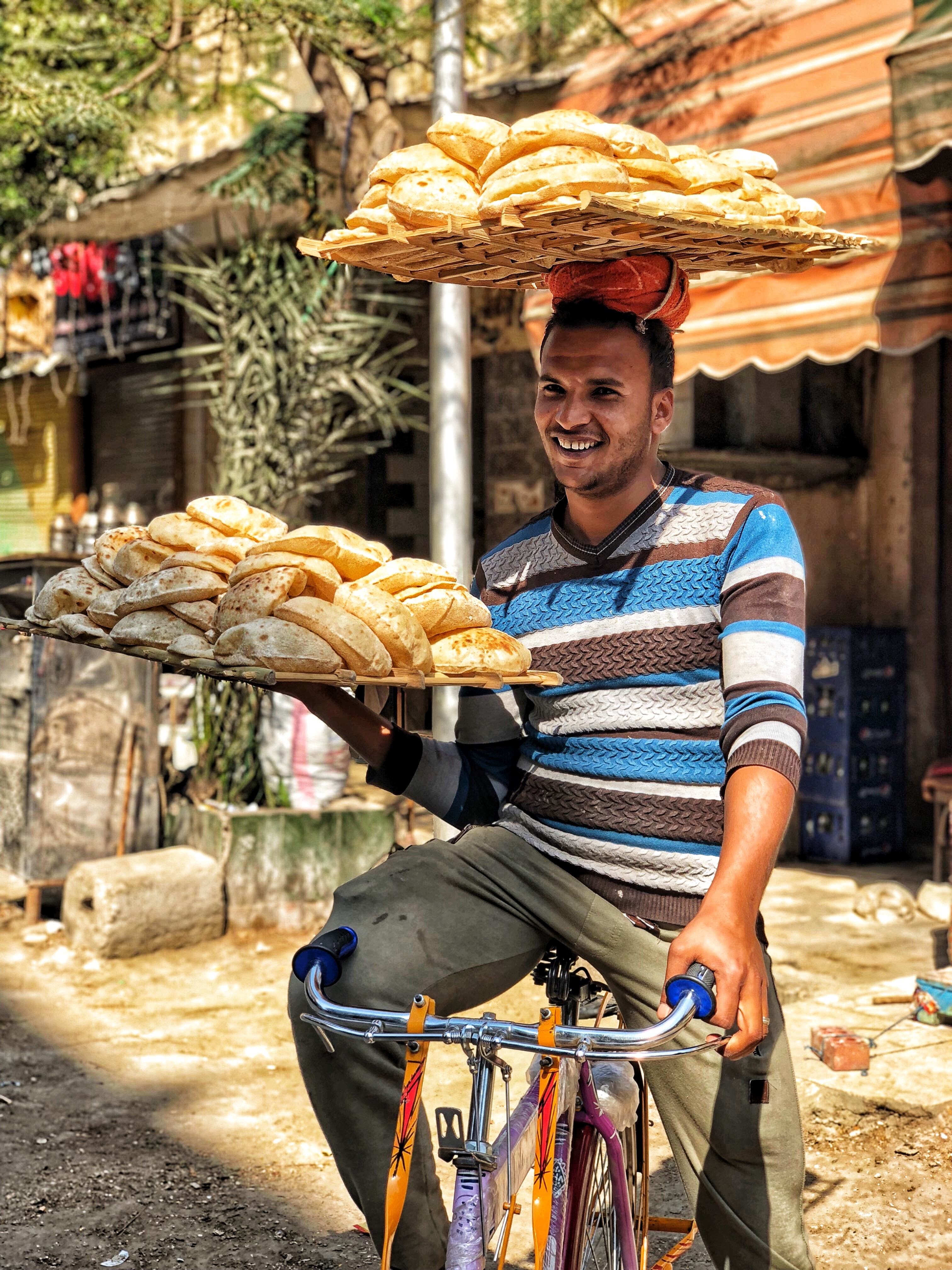
One of thousands of people who deliver bread around the city this way. It’s a miraculous feat.
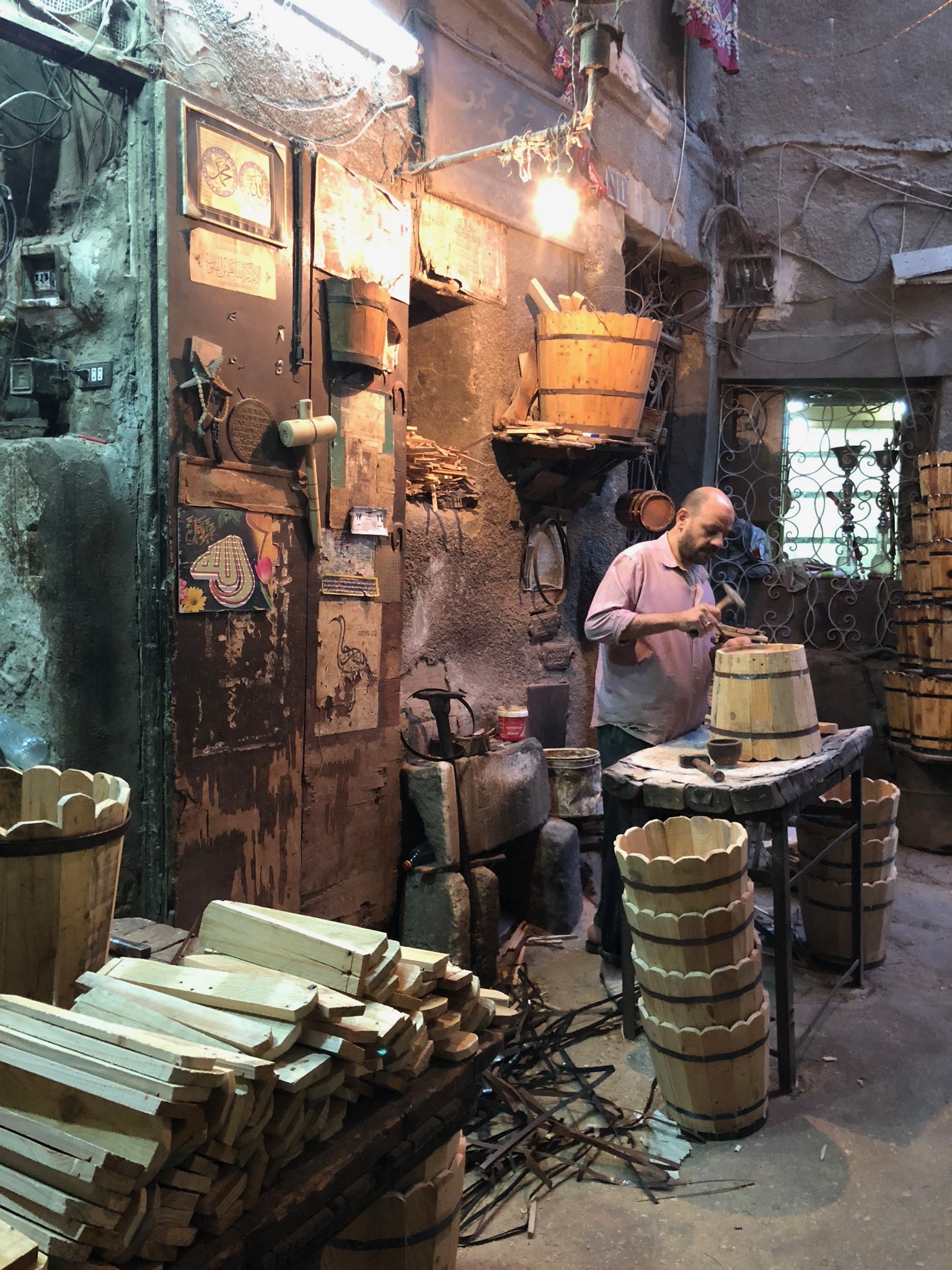
Here, it's not unusual to see people doing true trades, like this man making barrels, on the side of the street.
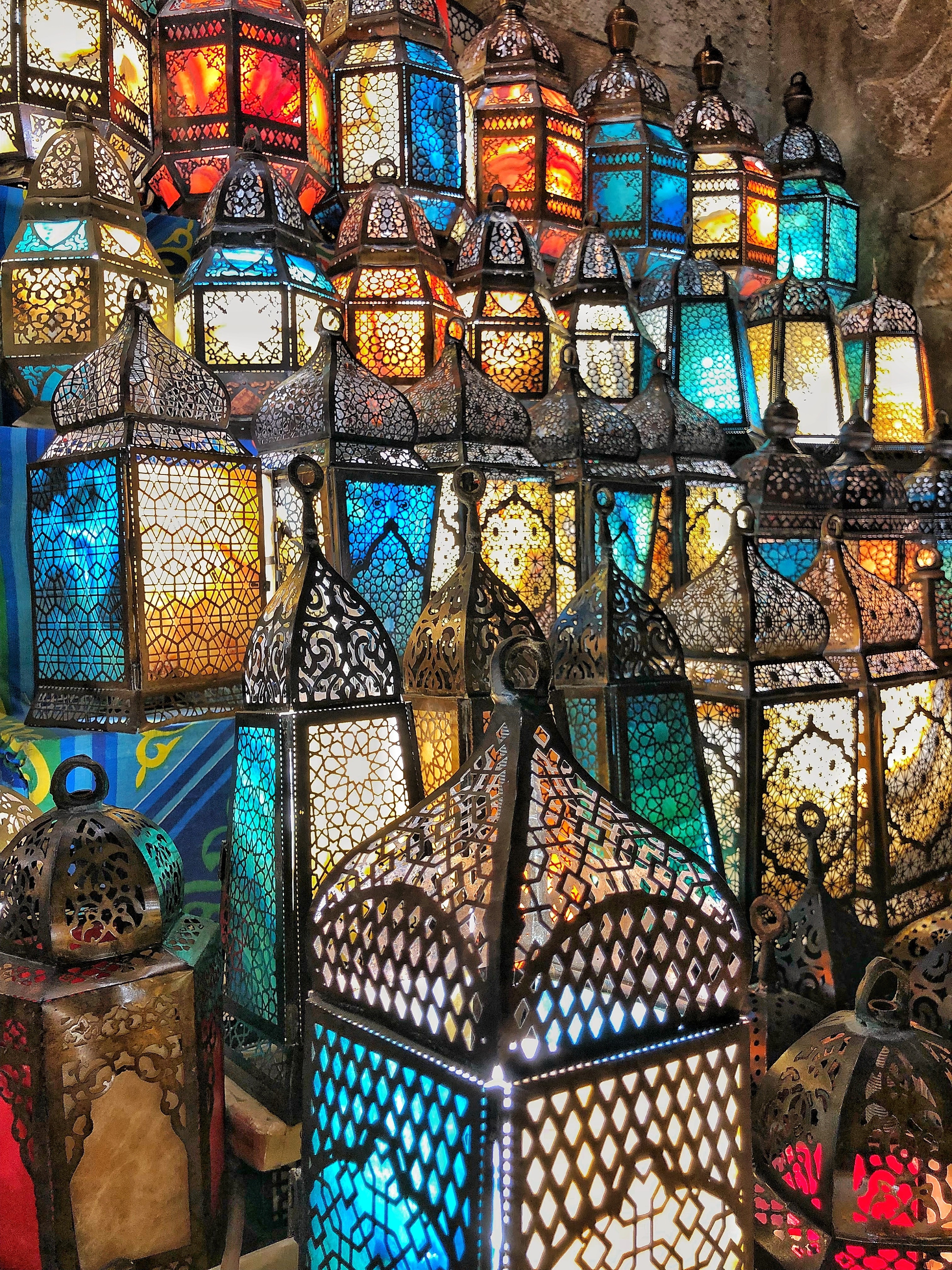
A beautiful display of classically designed lanterns for sale in the market.
Encouraged, we wander further, wending along the Nile that bisects Cairo east and west, past the chaos of Tahrir Square and into quieter alleys. Every block has an open-air bakery, boys racing to pull puffed pita-like breads from conveyor-belt-driven ovens, stacking them in rows on handmade wooden racks, darting to deliver them. Elderly men with knowing fingers sift spices on the ground; you wipe your eyes and sneeze, so overpowering are the aromas of their efforts. Women on squat stools use penknives to hollow baby eggplant to stuff.
We find Abo Ahmed Sheta standing just outside El-Gahsh—The Donkey—a dimly lit, open-to-the-elements café. He works a vat of oil, chattering as he forms a wet mash of herbs and crushed fava beans into loose balls, dropping them first into a wide bowl of coarse coriander seeds, coating them thickly, almost as breading. Then into the oil, where they puff and sizzle and brown into richly seasoned golf ball-size falafel. He offers me one, still crackling hot. The coriander wakes you in the most wonderful way, again as much crunch as seasoning.

Inside, over a sawdust-covered floor, a massive and dented steel urn of fūl—pureed fava beans—simmers and steams, set sideways over a flame. Sheta urges us to a green plastic table, which he overwhelms with crisp, aromatic falafel; piping hot fūl, which translates simply as slow-cooked; spiced tahini dip and baby leeks for dipping in it; bracingly pickled carrots and thick shreds of cabbage; mounds of flatbread; a sour, almost curdled blend of soft cheese and tomatoes; and—most notably—btingan, a spicy-sweet dish of chopped eggplant.
Everything is delicious, but it is the eggplant I go back for. A tumble of fried chunks, flecked with herbs and coated thickly in a vinegary-spicy tomato sauce. And there it is again, those same coarse spices that punctuated the patates mekhalel, that coated the falafel; they dot the eggplant, too, contrasting the vegetable’s soft flesh with pops of peppery spice.

Both dishes—the patates mekhalel and the btingan—show up over and again as our exploration of Cairo’s backstreet eateries continues, each a variation, but all delivering punches of flavor and texture by combining the brightness of vinegar, the freshness of copious herbs and the snap of barely crushed spices. Back at Milk Street, that intersection would be key to our versions of these recipes.
For the patates mekhalel, we stayed mostly true to Restaurant Zezo’s recipe. To allow the vinegar—we used white, as is common in Cairo—to more deeply season the potatoes, we added some to the cooking water, then drizzled them with more while they were still hot after draining. We also drew out deeper flavors from the coarsely ground cumin and coriander seeds by briefly blooming them in hot oil, better seasoning the dressing. A bit of honey balanced the acidity and spice.
For the btingan, we broke with tradition a bit. Most recipes call for frying the eggplant chunks—or sometimes using hard-to-find whole baby eggplant—in copious oil, but we felt this dulled the flavors of the dish and made it far too heavy. We preferred the taste and texture—not to mention ease—of instead tossing 1½-inch chunks of eggplant with oil, then broiling them until lightly charred. Another version we ate in Cairo replaced El-Gahsh’s spicy tomato sauce with harissa, a North African paste of chilies and spices. In addition to ease, this also enhanced and mirrored the flavors we already were adding with the coarse spices. White vinegar and a bit of honey for balance, and we hit all the right flavors and textures.
It took serendipity and a flock of pigeons, but we finally found the true flavors of Cairo.

